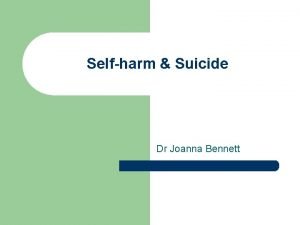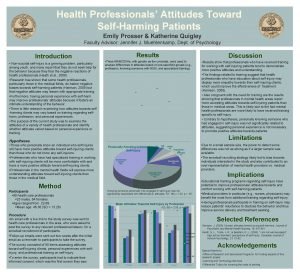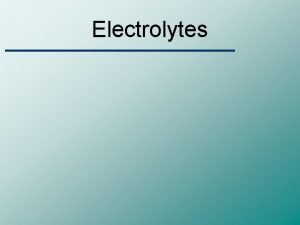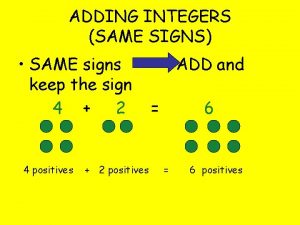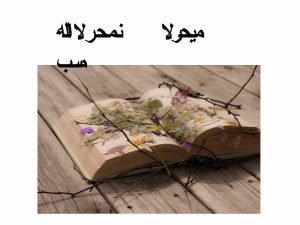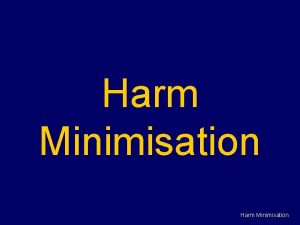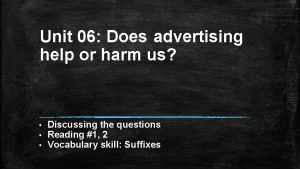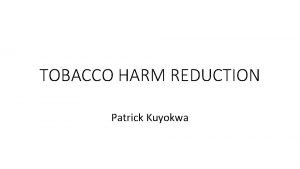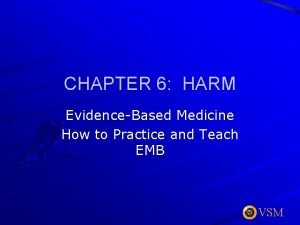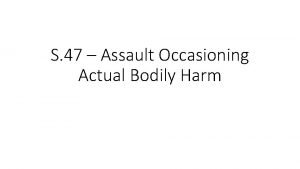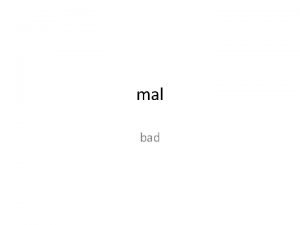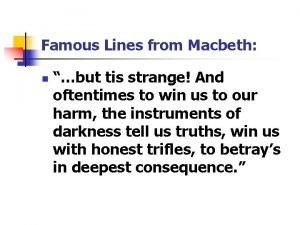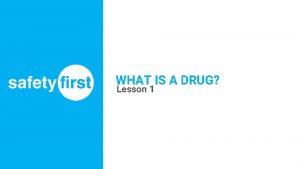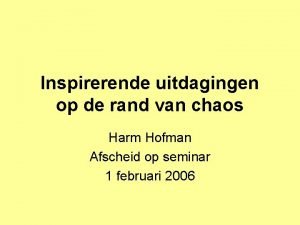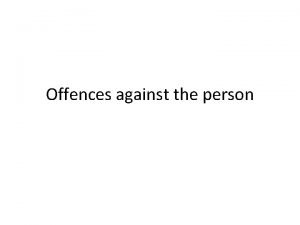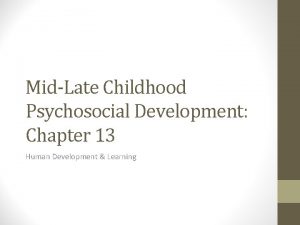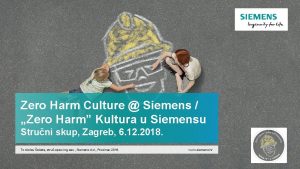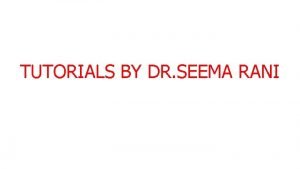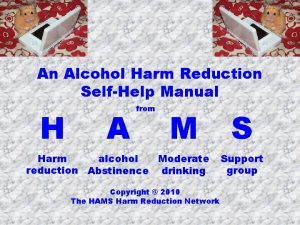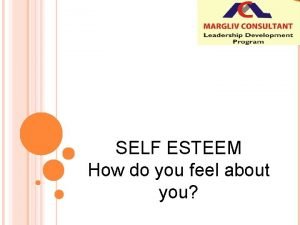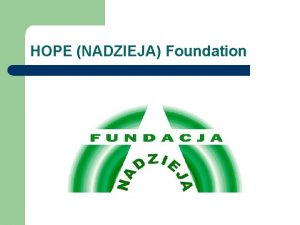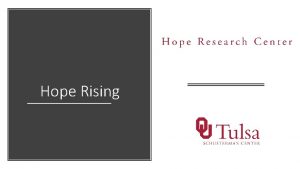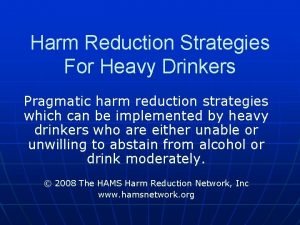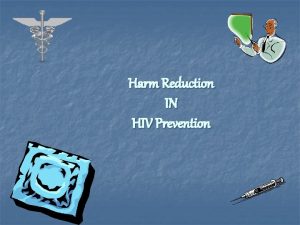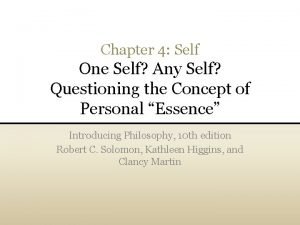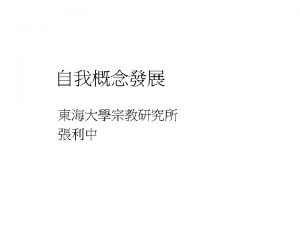Self Harm as a Sign of Hope Self











































- Slides: 43

Self Harm as a Sign of Hope

Self Harm as a Sign of Hope Anna Motz Consultant Clinical and Forensic Psychologist, Past President IAFP October 2009

Self Harm as a Sign of Hope “In the hopeful moment. . . the environment must be tested and re-tested in its capacity to stand the aggression, to prevent or repair the destruction, to tolerate the nuisance, to recognise the positive element in the antisocial tendency…” (Winnicott, 1956. )

Self Harm as Violence against the Self • In self harm, rage is split off and projected onto the body • The body as an object to be written on, tortured, and at times, mutilated • The mind is preserved as a safe place, as psychic pain is discharged onto body, and the body withstands this.

Self Harm as Hidden Violence • Typically female expression of violence • Often directed at hidden parts of the body • Woman are using one part of themselves as an object onto which to target rage • Releases tension, pain, feeling, and replaces thought

Development of Violence • Failure to mentalise (Fonagy and Target 1999. ) • “Violence, aggression directed against the body, may be closely linked to failures of mentalisation, as the lack of capacity to think about mental states may force individuals to manage thoughts, beliefs, and desires in the physical domain, primarily in the realm of body states and processes. “(Fonagy and Target 1999: 53) • Objectification of oneself and others—no real sense of subjectivity.

Cycle of Violence • Cycle of violence; develop violent fantasies as release, escape (Welldon, 1988)---failure of fantasies to comfort, discharge tension. • Addiction to violent action—against the self or others • Compulsion to act-brings short-lived sense of euphoria • Release only temporary: toxic affect returns

A Psychological Model of Female Violence (Motz, 2001) • Violence seen primarily as communication • As a response to powerlessness • Solution (however maladaptive it seems)to underlying psychological difficulties • For women often hidden, in the home, against the self, in secret, private places

Self-harm as an Act of Hope • Assault the environment (the body) to see what it can withstand, and provide • Allows the mind to be freed temporarily of toxic material, painful memories • Expression of unarticulated feelings • Ultimately an attempt to reach out to others in the hope of a response –attempt at relating

Self Harm as Communication • Self harm is distinct from suicide or suicide attempts: • paradoxically, self-injury is usually a life sustaining act • It is communication through the use of violence against the self, and its impact

Clinical Illustration Self Harm as Life Preservative Violence

Scalding, Blood-letting and Cutting : Miss Y • Miss Y was a 34 year old resident of a therapeutic community on a forensic unit • She had a history of physical abuse and emotional neglect, suspected sexual abuse • At times of great distress she poured pouring water on herself, cut herself and meticulously drained blood from wounds

“A Platform for Performance” • Miss Y described being in the TC ward unhelpful: it encouraged histrionic and public expressions of distress • She preferred to hurt herself in private and then present herself to the staff much later, once her wounds or burns had healed • She admitted to “enjoying” taking care of her own injuries, but then showing them to others, and seeing the scars heal over time

Bodily Countertransference: Initial • My eyes were drawn to her dramatic, visible scars, forming criss cross pattern all over her arms--I felt sick and compelled to stare • I had a powerful urge to interrupt the session to leave: being in the room was almost unbearable • Sight of naked arms with scars, mottled flesh compelling and alarming

Therapy Stages and Themes • Introduction: Creativity and Seduction • Poetry-presenting me with realms of written work • Images-verbal, visual, visceral • Dream diaries-filled to the brim • Developing trust and hinting at untold and unbearable secrets

Retreat from Therapy • After this initial outpouring of thoughts, feelings (first three months of therapy)Miss Y began to retreat into a non verbal state • “I can think only in images, and flashes, not words” • Intensification in self harm--internal and external • Lying down in the sessions, curling up, • Despair at thought of stopping self harm: “I feel I will have lost my best friend”

Violence to Self as Displacement • Miss Y became terrified that as she gradually gave up her self-harm activities she would become more likely to attack others, or set fires (as she once had) • She revealed that blood letting had followed her own experience of a life-threatening operation -sense of power, control and omniscience-knew what was inside

Cutting up and Cutting out • Afer initial reduction in self harm, Miss Y became very scared, and then a period followed where self harm intensified, and then periods of time when she was silent, rocking, and dissociated. • Cutting internally, a letter to tell me she is storing up weapons to use against herself. • Loss of focus in powerful and unreachable states of pure dissociation--I am cut out and words are lost--she has withdrawn.

“Bodily Countertransference”Intensified • As the self harm becomes more evident my mind is assaulted more powerfully and my body is hyper -responsive to her communications. • I respond with intense visceral, physical feelings to the projections that are put into me. • Primitive defences are expressed in this way and the violence is enacted in part through my responses--my thinking is attacked and my body brought increasingly into play.

Amnesty and Recovery • After this crisis period of several weeks, where she returned to self-harming, Miss Y, gradually became less preoccupied with it, and focussed on words, on art materials and on engaging in therapy and with the team • She handed in her secret supplies of razors, safety pins and broken cd cases: sense of trust in the capacity of staff to keep her weapons from her, and hold her in mind

Meaning of Miss Y’s self harm • • Body as text Physical mode of expressing psychic pain Making private experiences public Showing not saying, in dramatic and tangible form

The Signficance of Self Injury : Understanding its Symbols • The significance of the body parts that are harmed: • Arms: evoke mother’s--that are intended to hold and comfort, but in this case, have not. • Arms that could reach out, but instead, fold in, keeping away. • Arms that held her down and beat her. • Scars all over, keep people away, no touch, no holding • Public expression of private pain (Adshead) and concrete symbol of this secret trauma.

Lace-making in the Dark • Slow and gradual engagement-profound difficulties in trusting me • Inevitable moments of regression, and worsening of violent fantasies and behaviour. • Danger of my recreating neglectful or perverse parenting, potential to re-enact earlier abuse, /abandonment or intrusion

Powerful Functions of Self Harm • Miss Y used it to ward off thoughts of suicide, or other forms of emotional disorganisation: life sustaining coping mechanism • Released tension • Communication through her use of her body (sometimes directly in the form of viscerally felt projections) of her mental state

Choosing Physical over Psychic Pain • Elements of control, self-regulation of the physical, secrecy, risk taking and privacy demonstrate the degree of conscious choice when and how to self harm • This does not preclude the possiblity of unconscious motivations that take the form of compulsions—the violent thought cannot be kept in the mind

Self harm as Affective Communication • Idea of “signing with a scar” (Straker, 2006) • Using the marks on the body to signify one’s state of mind to another • Language of the body seen as more primitive, direct form of communication than words • Primacy and directness of bodily states and the immediacy/violence of their ‘voice’

Psychological Motivations (self-directed) • • Feeling real Distraction Expression of anger Get out of intolerable state Affect regulation Assert sense of control Create sense of ownership of own body

Self Harm and Life Preservation • Reflects a choice between chaos, gray submersion in depression and articulated, delineated feeling-focusses the mind • Self harm creates a boundary between feeling and not feeling, gives shape, time, colour and substance to sense of total deadness or fear-creates a dimension • Brings back the feeling of being real (alive), contact with external world when numb

Psychological Motivations (other directed) • Generate response in others, including medical treatment, suturing, cutting of ligature. nursing • Attack carers who fail to protect • Communicate rage and distress • Defence against intimacy (regulate distance) • Keep people at bay-warped skin as barrier • Enlist help, support or concern

Self Harm as Truth-telling • Attack on beauty • Through mutilation the self-harmer wants to reveal underlying internal damage • She is demonstrating that there is something real, hurt and ugly underneath the surface • The brutality of self-harm is felt to mirror the violence of being seen (only) as a thing of beauty

“Hurting as a kind of healing” • • • Paradoxical nature of self-harm Fantasy of toxic elimination Reality of release of intolerable feeling Distraction from psychic pain At times some pleasure in the pain Driven by the hope of healing

Talisman • • • Significance of scar is profound “How deep is your damage? ” Marking on the flesh invisible wounds Mapping memories Physical, tangible evidence of wound Symbol of passing through initiation of sorts (anthropological evidence of significance of scarification)

Dialectical Movements in Self Harm • The split self graphically articulated • The self plays different roles in relation to itself • It is both aggressor, harmer • And the target of the violence • And finally, the Nurse part of the self who can tend the wounds, soothe injuries and act as witness to these.

The Divided Self: Victim/Perpetrator Identification with the aggressor (Anna Freud, 1936) Here body represents the victim, the mind that chooses to attack it is in identification with the aggressor, as it inflicts pain on the body

Childhood Sexual and Physical Abuse and its Link to Self Harm • Links with shame, guilt, secrets, taboo • Use of the body as site of shame, trauma and memory • Repeats violations of the skin • Dissociation associated with severe abuse and with self harm

Self harm as Affect Regulation • Way of escaping intolerable states of mind • Releasing high levels of anxiety, depression and anger • Controlled method of managing emotions at times of increased and unbearable stress • Use of violence against the self to distract from guilt of fantasies of violence against others

Female Perversion • • Women’s anger turned against the self Defence against intimacy Secret and powerful expression of rage Cycle of behaviour, thoughts, feelings and fantasies that has an addictive, compulsive quality--with euphoric sense of release • Symbolic attack on mother’s body • Enjoyment (at some level) of secrecy, rituals, risk-taking and damage

Self Harm as Violence to Others • The witnesses to self harm, carers who failed to protect, are indirect targets of rage • Tremendous symbolic hostility and violence --murderous attack on the mother’s body • Generates feelings of pain, disgust, horror and guilt in carers

Reciprocal Violence Consultant psychiatrist Tim Kendall, the co-director of Royal College of Psychiatrists’ said that in extreme cases doctors and nurses had stitched up patients' selfinflicted injuries without giving them an anaesthetic. (seen as undeserving of care or treatment as “legitimate” injuries) The view some staff take is 'well you cut yourself without anaesthetic so you don't need one now', " said Dr Kendall.

Finding Unconscious Hope “Patients are trying to live with overwhelming emotional pain and project this into staff through various communications such as self injury, very direct sexualised communications, physical assaults and vicious personalised attacks…the unconscious hope is that the nursing staff can do something positive with the communication. , . ” (Aiyegbusi, 2004)

Managing Self Harm and its Impact • Supporting staff teams through Reflective Practice • Supervision • Retaining neutrality • Working “under fire” • Acknowledging countertransference • Understanding underlying meaning

Self Harm as a Sign of Hope • It is essential to understand the underlying meaning of self harm • Self harm to be viewed as communication • Person who self-harms should be offered help to de-code their bodily language, and put into words, what needs to be articulated • It is also crucial that the affective content of communication can be borne, and contained • Through responding to the request for contact change becomes possible.

 Sign shapes meaning
Sign shapes meaning Joanna self harm
Joanna self harm Self harm toolkit essex
Self harm toolkit essex Emily self harm
Emily self harm Green is symbol of
Green is symbol of Differentiate ideal self from actual self by giving example
Differentiate ideal self from actual self by giving example Hypermagnesemia treatment
Hypermagnesemia treatment Kernigs sign
Kernigs sign Cuong nguyen md
Cuong nguyen md When the sign are the same and keep the sign
When the sign are the same and keep the sign Trousseau's sign
Trousseau's sign Calculate number needed to harm
Calculate number needed to harm Harm minimisation
Harm minimisation Does advertising help or harm us?
Does advertising help or harm us? Free from harm report
Free from harm report Being legally responsible for causing harm is:
Being legally responsible for causing harm is: Node of ranvier channels
Node of ranvier channels Harm reduction
Harm reduction Endel härm
Endel härm Hidden harm hazing
Hidden harm hazing Number needed to harm
Number needed to harm Carry 3.hali
Carry 3.hali Alcohol harm reduction worksheets
Alcohol harm reduction worksheets Clinical harm review
Clinical harm review Reference of globalization
Reference of globalization Harm reduction programme
Harm reduction programme Abh vs gbh
Abh vs gbh Harm van der werf
Harm van der werf Wishing evil or harm to others
Wishing evil or harm to others Cumulative harm wheel
Cumulative harm wheel Macbeth famous lines
Macbeth famous lines Nyhre
Nyhre Harm reduction strategies
Harm reduction strategies Where does beowulf see a tremendous sword
Where does beowulf see a tremendous sword Harm hofman
Harm hofman Abh and gbh difference
Abh and gbh difference Cotten fever
Cotten fever Harm knolle
Harm knolle Industry versus inferiority
Industry versus inferiority Zero harm
Zero harm Nnh calculation
Nnh calculation Fishermen in the cold sea would not harm
Fishermen in the cold sea would not harm Harm reduction worksheets
Harm reduction worksheets How do you feel
How do you feel

